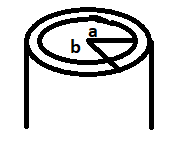A long, cylindrical tube of inner and outer radii a and b carries a current i distributed uniformly over its cross section. Find the magnitude of the magnetic field at a point
(a) just inside the tube
(b) just outside the tube
Given:
Inner radii of tube = a
Outer radii = b
Current distributed over its cross section = i
Diagram:

Formula used:
Ampere’s circuital law states that the line integral of the magnetic field for a closed surface is μ0 times the current enclosed by the surface.
![]() ,
,
Where
B = magnetic field, dl = line element, μ0 = magnetic permeability of vacuum, I = current enclosed.
(a) Inside a conducting tube, I (current enclosed) is 0.
Hence, by Ampere’s circuital law, ![]() = 0 => B = 0.
= 0 => B = 0.
Hence, the magnetic field just inside the tube is 0.
(b) Just outside the tube, the distance from the center is b.
Hence, we consider an Amperian loop of radius b from the center.
Hence, from Ampere’s circuital law:
![]() ,
,
Where B = magnetic field,
dl = line element, μ0 = magnetic permeability of vacuum, I = current enclosed.
In this case, ∮dl = 2πb (circumference of the loop of radius b)
Therefore, B x 2πb = μoi (since the total current enclosed is i).
Hence, the magnetic field at a point just outside the tube = μoi/2πb(Ans)